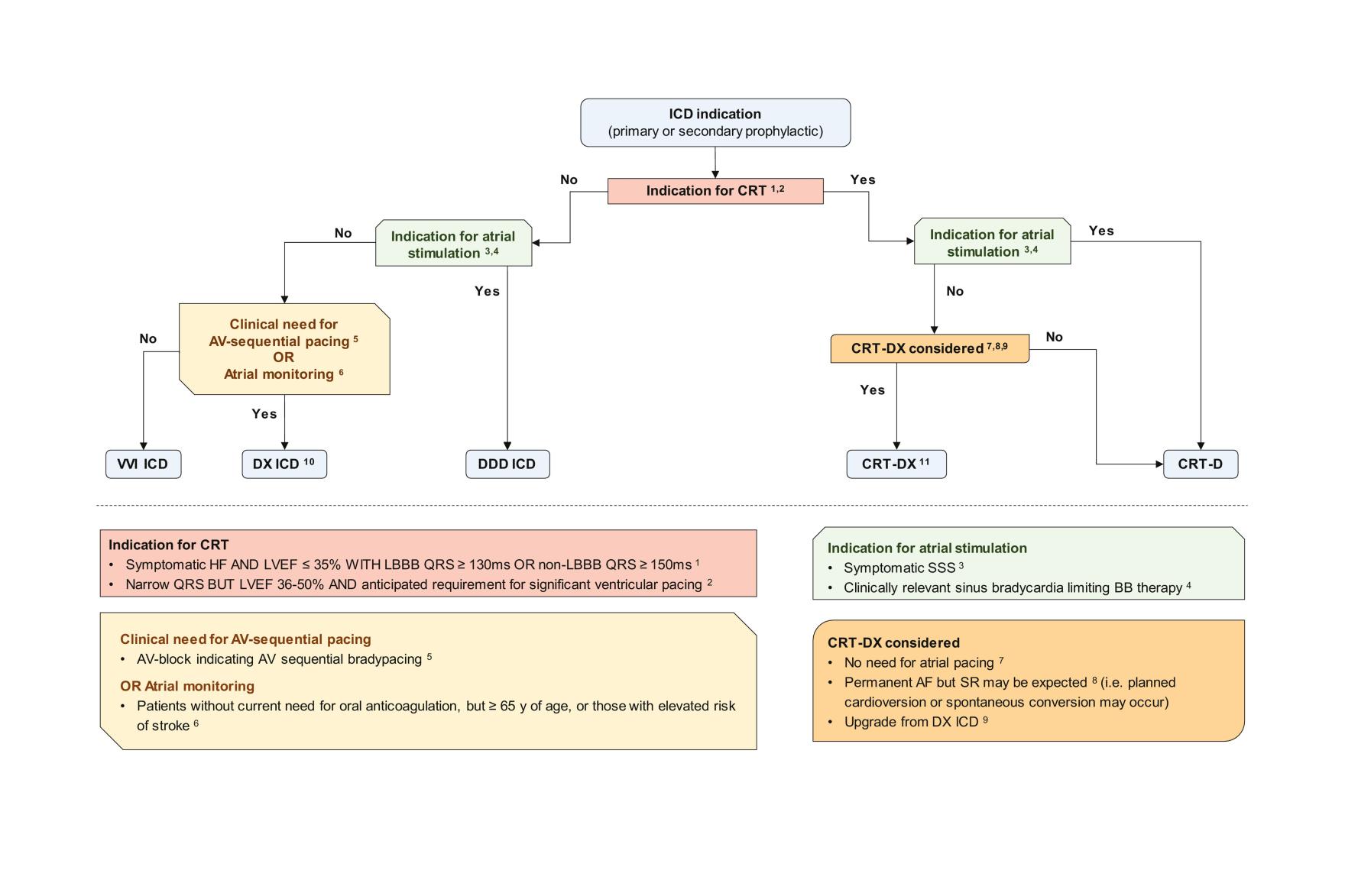How to Select ICDs and Foster Early Detection of Atrial Fibrillation
The incidence of atrial fibrillation (AF) in patients with implantable cardioverter-defibrillators (ICDs) is approximately 21 percent (mean annual probability)1 and is often undetected – and therefore untreated.

Single-chamber ICDs account for a significant proportion of ICDs implanted, which, due to the missing atrial lead, cannot provide atrial sensing nor atrial rate.1 On the other hand, DX Technology, available on single-lead ICDs with an atrial floating dipole, can enable earlier AF detection compared to standard single-chamber ICDs.2,3 To aid the selection of the ICD device type to be implanted, Dr. Mate Vamos from the University of Szeged, Hungary, together with a panel of experts, recently introduced a helpful ICD selection flowchart that also defines potential indications of the DX Technology.
Why Early AF Detection Matters
AF affects more than 30 million people worldwide,4 with that number estimated to increase by more than twofold until 2060.5 AF patients have a 1.5- to 3.5-fold increased risk of death, as well as five times the risk of stroke.5,6 In addition, AF increases the risk of heart failure, cognitive decline/vascular dementia, depression, impaired quality of life and hospitalizations.5
Silent or subclinical asymptomatic AF is also common: Approximately one-third of patients with AF do not experience any obvious arrhythmia-related symptoms.4 Since silent, asymptomatic AF has a similar impact on mortality and morbidity as symptomatic AF, its detection is paramount for a timely therapy start – and help in preventing the disease from progressing to a treatment-refractory problem.4

I would recommend DX ICDs for patients who would benefit from proper atrial sensing. Since for the majority of typical ICD recipients anticoagulation would be necessary in case of the detection of AF, we may consider selecting this type of device in patients who are otherwise not candidates for atrial pacing and still not on oral anticoagulants.
Guidelines for AF Detection and Monitoring in ICD Patients
Age is one of the most important risk factors for AF, so the current AF Guidelines of the European Society of Cardiology (ESC) and the European Heart Rhythm Association (EHRA) recommend opportunistic screening for AF by pulse taking or an ECG rhythm strip in all patients ≥65 years of age. In addition, the guidelines recommend interrogating pacemakers and ICDs on a regular basis for atrial high-rate episodes (AHRE).5
Atrial diagnostics can be achieved with a single-lead ICD system that contains a floating dipole in the atrial part of the lead, termed DX due to their Diagnostic eXtension capability. The DX Technology offers several advantages, explains Dr. Vamos: “I think we implanting physicians all like to work in the daily clinical practice with devices that are as simple as possible, but have as many features as possible. And this is the DX ICD technology’s aim: It enables true atrial sensing without an atrial lead, which allows better AF detection compared to standard single-chamber ICD systems. On the other hand, it carries lower risk for complications such as puncture-related complications, lead dislodgment and infection, and it may also shorten procedure and fluoroscopy times.”
Combining DX with remote patient monitoring, BIOTRONIK Home Monitoring®, enables healthcare professionals to receive timely alerts about possible AF episodes, thereby facilitating early AF detection. Furthermore, DX can also be considered for patients indicated for cardiac resynchronization therapy (CRT) without atrial pacing, using CRT-DX systems, which use only two leads instead of the usual three.
Decision Flowchart for ICD Selection
Although the DX systems have been available for years, they were unfortunately underutilized, explains Dr. Vamos: “I think the main reason for the lower awareness of the technology was the lack of clear guidance based on scientific evidence. We wanted to fill this gap by summarizing the accumulated study data on the DX ICD and CRT-DX systems and incorporating these with the current European and American guidelines into a systematic algorithm for ICD selection.”
The resulting flowchart of Dr. Vamos and his colleagues (Figure 1) was published in 2021.6 “In general, I would recommend DX ICDs for patients who would benefit from proper atrial sensing,” Dr. Vamos summarizes the main findings. “Since for the majority of typical ICD recipients anticoagulation would be necessary in case of the detection of AF, we may consider selecting this type of device in patients who are otherwise not candidates for atrial pacing and still not on oral anticoagulants. Moreover, it could be a good choice for patients who do not fulfill an absolute indication for bradypacing or CRT at the time of implantation, but already have a mild AV or ventricular conduction problem and therefore may develop higher degree conduction abnormalities or indication for resynchronization therapy in the future.”
Figure 1: Decision flowchart for ICD device selection (Source: Vamos et al. Trends Cardiovasc Med. 2022;32:84-89). Abbreviations: AF: atrial fibrillation; AV: atrioventricular; BB: beta-blocker; CRT: cardiac resynchronization therapy; ICD: implantable cardioverter defibrillator; LBBB: left bundle branch block; LVEF: left ventricular ejection fraction; SR: sinus rhythm; SSS: sick sinus syndrome.
Regarding a typical scenario for DX use, Dr. Vamos recalls the recent case of a 67-year-old male who some weeks ago was referred for ICD implantation after successful resuscitation following ventricular fibrillation: “This patient suffered from hypertension and underwent PCI [percutaneous coronary intervention] due to myocardial infarction some years ago. There was currently neither myocardial necrosis by lab tests, nor was a new target lesion identified during coronary angiography, and echocardiography demonstrated a preserved ejection fraction (EF 52%). So, this was a clear case for secondary prophylactic ICD implantation. Based on the first-degree AV-block on surface ECG (PQ 240 ms) but narrow QRS and an elevated risk of stroke (CHA2DS2-VASc score of 3), we implanted a DX ICD and put the man on Home Monitoring.”
Many Parties Can Benefit From DX Systems
Benefits of the DX Technology are clear, according to Dr. Vamos: “I think after a very short learning curve, one will acknowledge that the simplicity of the implantation of a DX ICD is very similar to a single-chamber ICD implant. At the same time, patient care could be improved substantially as compared to standard single-chamber ICDs.” One of these patient benefits is, for example, timely initiation of OAC [oral anticoagulation] therapy after early AF detection – which could significantly reduce the stroke risk.
In addition, he points out that the DX Technology may also be relevant for hospital administrations, especially when combined with remote monitoring: “This makes it possible to reconsider and streamline the overall organization of patient flow and follow-up, thereby facilitating the efficient use of hospital resources while helping to provide a better individualized care – especially for patients with elevated risk of AF or stroke.”
Conclusion: More Awareness is Needed
With his publication, Dr. Vamos hopes to raise awareness for the utilization of DX ICDs so that they may become the standard of care for certain patient populations. “It would be desirable if scientific societies would incorporate this option into their official guidelines. Based on such recommendations, other manufacturers may also offer similar technology in their portfolio, because this technology really meets a need,” concludes Dr. Vamos.
References:
1. Reinhold T, Belke R, Hauser T et al. Cost Saving Potential of an Early Detection of Atrial Fibrillation in Patients after ICD Implantation. Biomed Res Int. 2018;2018:3417643.
2. Thomas G, Choi DY, Doppalapudi H. Subclinical atrial fibrillation detection with a floating atrial sensing dipole in single lead implantable cardioverter-defibrillator systems: Results of the SENSE trial. J Cardiovasc Electrophysiol. 2019;30(10):1994–2001.
3. Biffi M, Iori M, De Maria E et al. The role of atrial sensing for new-onset atrial arrhythmias diagnosis and management in single-chamber implantable cardioverter-defibrillator recipients: Results from the THINGS registry. J Cardiovasc Electrophysiol. 2020;31(4):846–853.
4. Dilaveris PE, Kennedy HL. Silent atrial fibrillation: epidemiology, diagnosis, and clinical impact. Clin Cardiol. 2017;40(6):413–418.
5. Hindricks G, Potpara T, Dagres N et al. 2020 ESC Guidelines for the diagnosis and management of atrial fibrillation, developed in collaboration with the European Association for Cardio-Thoracic Surgery (EACTS): The Task Force for the diagnosis and management of atrial fibrillation of the European Society of Cardiology (ESC), developed with the special contribution of the European Heart Rhythm Association (EHRA) of the ESC. Eur Heart J. 2021;42(5):373–498.
6. Vamos M, Nemeth M, Balazs T, Zima E, Duray GZ. Rationale and feasibility of the atrioventricular single-lead ICD systems with a floating atrial dipole (DX) in clinical practice. Trends Cardiovasc Med. 2022;32(2):84-89.




